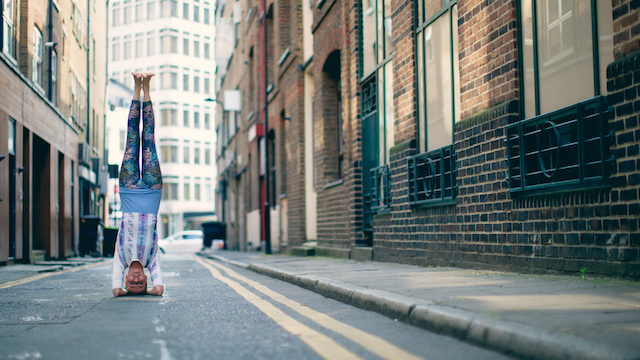Everyone that practices yoga probably has a different idea of what taking their practice off their mat and into the rest of their lives means.
So this is simply my personal experience of just one of the ways time spent on my yoga mat has affected the rest of my life.
Most of the classes I teach—and probably lots of the classes you attend—start off pretty slowly with some gentle floor-based movements to start opening up the body and to bring people’s attention to both how their body is feeling and to the rhythm of their breathing.
The physical movements then gradually build in demand and intensity until they reach a certain most challenging point, before we begin to wind down again toward relaxation at the end of class.
I’ll cue my students to inhale and exhale in time with certain movements, and also to notice what’s happening with their breath at certain points in the class.
I ask my students to establish a steady, calm rhythm of breath at the beginning of class when they are lying still. Then, I’ll begin to challenge them by bringing in some simple movements. And then challenge them to keep the rhythm of their breath with some more demanding movements. And then challenge them further with even more demanding movements.
~
One of the most important things you can do for your vagina and your sex life—to avoid a world of problems later? Check out this device and get a free bag of craft coffee (code; EJCOFFEE)>>
~
This, for me, is key to one of the wider benefits of modern asana classes.
Yoga classes are often structured this way for a number of reasons, such as gradually warming up the body so it’s ready for more demanding postures and teaching students what they need to do in more accessible poses before asking them to try harder movements.
But in using that structure, I’m also trying to teach them the skill of keeping their breathing calm, steady, and focused in progressively more challenging situations.
If we can keep taking deep calming breaths even when asked to do something unfamiliar, daunting, or stressful on our yoga mats, imagine how that might help us next time we go for a job interview. Or can’t get our baby to stop crying and go to sleep. Or have to make a big presentation at work.
I used this technique when I went for a job interview recently. Admittedly, since I’ve been teaching yoga, interviews are a world away from the ones I used to go to with law firms. But they can be nerve-wracking nonetheless—you’re still going to be asked questions by someone you’d like to impress, and you still want to sound like you know what you’re talking about!
I made sure to get there a little early to have time to run to the bathroom before it started. In doing so, I gave myself a little space to let go of my journey there and take a few slightly deeper breaths. I took a couple of minutes to find a slow, steady rhythm of breathing and made sure I could maintain that before I went back outside.
Once the interview had begun, I consciously went back to that same unhurried breath whenever it wasn’t my turn to speak. Calmer breathing allowed me to stay focused, which helped me think on my feet better and give more concise and informative answers (I got the job!).
Calm, focused breathing in challenging situations. That’s got to be a skill worth taking off your yoga mat, right?
`
~
Author: Olivia Marley
Image: Author’s own
Editor: Callie Rushton
Ready to join?
Hey, thanks so much for reading! Elephant offers 1 article every month for free.
If you want more, grab a subscription for unlimited reads for $5/year (normally, it's $108/year, and the discount ends soon).
And clearly you appreciate mindfulness with a sense of humor and integrity! Why not join the Elephant community, become an Elephriend?
Your investment will help Elephant Journal invest in our editors and writers who promote your values to create the change you want to see in your world!
Already have an account? Log in.
Ready to join?
Hey, thanks so much for reading! Elephant offers 1 article every month for free.
If you want more, grab a subscription for unlimited reads for $5/year (normally, it's $108/year, and the discount ends soon).
And clearly you appreciate mindfulness with a sense of humor and integrity! Why not join the Elephant community, become an Elephriend?
Your investment will help Elephant Journal invest in our editors and writers who promote your values to create the change you want to see in your world!
Already have an account? Log in.

 Share on bsky
Share on bsky







Read 0 comments and reply